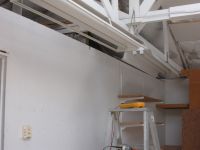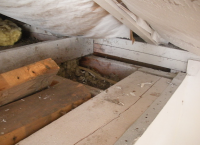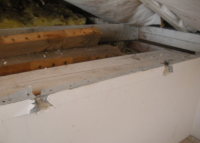
Fixing 50-year-old electrical hazard
klugesmith, Thu Jul 30 2015, 10:33PMGot an unexpected electric shock last Sunday, while helping my wife clean out her late parents' garage. It had been converted to an art studio and office in the early 1960's. I climbed an aluminum stepladder to secure some loose insulation batts overhead. Reaching over to one side, I touched the top of a partition wall and got zapped. Not too strongly, but it happened more than once as I continued with the original task.

The drywall corner bead along top of wall was electrically charged. Its upward-facing metal surface is exposed for the whole length of the wall. For the next session, on Wednesday, I brought a voltmeter and set out to discover the root cause. Two sections of metal are visible while standing on the floor; left one is floating and right one is tied to 118 volts AC.

The prime suspect was a sharp-edged notch where some Romex entered the wall, just to the right of that visible joint.

For want of a hacksaw, I had to tear and twist the metal with a large diagonal-cutting pliers. Its handles were electrically insulated except close to its hinge, as I was reminded a couple of times. Soon this notch, and the first nail to the right, were exonerated. Meter showed that the right section was still live. Could have determined that with my bare hands, but receiving electric shocks on purpose is not my idea of fun.

Aha -- there's more Romex, even at the far right end of this wall.

Time for a binary search. In this picture the isolated middle section is still energized.

I started de-mudding and pulling out the horizontal nails, with help from a plastic-handled putty knife. After nail #2 was backed out a little bit, it sprang back into the wall! Must have been stuck in an electrical cable. With that nail all the way out, the sheet metal bead was no longer charged.

The offending nail was aligned with a ceiling joist, so the cable damage can not be inspected from either side of the joist.

I bet I know how this happened. The "office" on far side of the wall must have been finished first. Its electric lights and outlets were wired with cable that ran over exposed 2x4 framing on our side of the wall. "Our" side was drywalled at a much later date, I bet in the 1980's when roof insulation and a skylight were also installed. Will see if my wife remembers. The guy who finished the top of the wall forgot, or never knew, there were wires running between the drywall and the framing.
This was a first for me, but is surely familiar to most people who earn their living as electricians / contractors / handymen.
Re: Fixing 50-year-old electrical hazard
radiotech, Fri Jul 31 2015, 05:10AM
Electricians used wooden stepladders, wooden folding rulers.
radiotech, Fri Jul 31 2015, 05:10AM
Electricians used wooden stepladders, wooden folding rulers.
Re: Fixing 50-year-old electrical hazard
Mads Barnkob, Fri Jul 31 2015, 06:31AM
I can assure you that a wooden ladder is no holy grail to untouchableness. There are so many grounded objects around you that the effect is gone in modern today, back in the days where constructions was made of wood it was a good idea. Today you have to ground every metallic construction part, so there is plenty to go with, but that should however also take care of a fault like kludgesmith's.
Nails, screws, drills, pipes etc going into cables ruining their insulation is just about everyday work for a electrician. Latest I saw posted on facebook was a water pipe shot under a road that penetrated a old 10kV tar/oil insulated cable, a whole town went black. It is no different that the carpenter going crazy with his nail gun :)
Mads Barnkob, Fri Jul 31 2015, 06:31AM
I can assure you that a wooden ladder is no holy grail to untouchableness. There are so many grounded objects around you that the effect is gone in modern today, back in the days where constructions was made of wood it was a good idea. Today you have to ground every metallic construction part, so there is plenty to go with, but that should however also take care of a fault like kludgesmith's.
Nails, screws, drills, pipes etc going into cables ruining their insulation is just about everyday work for a electrician. Latest I saw posted on facebook was a water pipe shot under a road that penetrated a old 10kV tar/oil insulated cable, a whole town went black. It is no different that the carpenter going crazy with his nail gun :)
Print this page